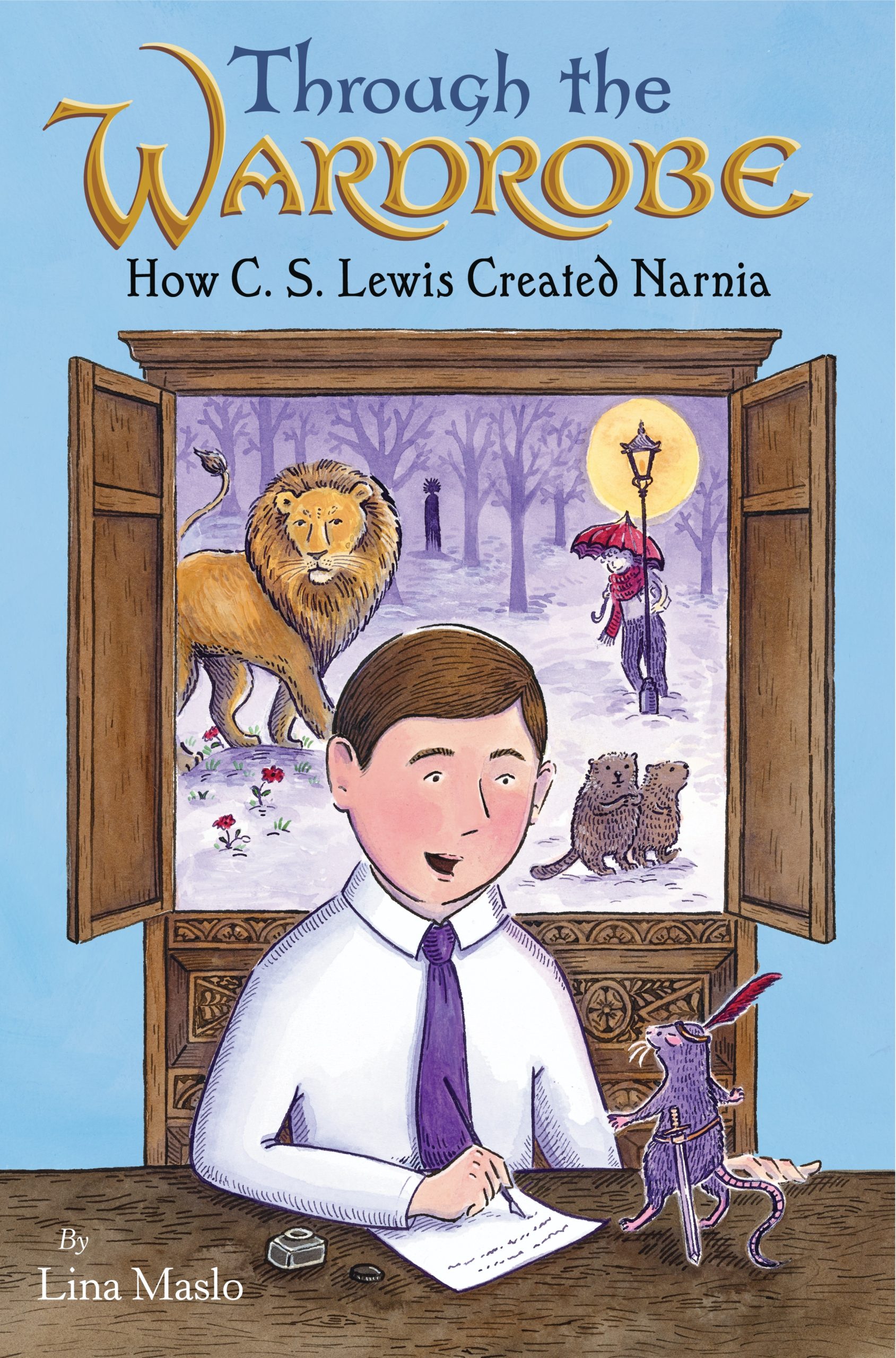
Hey, everybody! Welcome back to “Through a New Wardrobe”, where we sit down and chat with some of today’s hottest writers who have been influenced by CS Lewis and the Land of Narnia. For today’s interview we sit down with author and illustrator Lina Maslo and discuss her new book, Through the Wardrobe: How C. S. Lewis Created Narnia

NF: Tell us a bit about yourself, for our readers that might not know much about you.
LM: My name is Lina Maslo, and I am an author and illustrator of children’s books. My first published children’s book is called Free as a Bird: the Story of Malala, and it is a picture book biography of Malala Yousafzai, the youngest winner of the Nobel Peace Prize. Through the Wardrobe is my second published book. I grew up in Florida, and graduated with a Degree in Art from New College of Florida. I’m also married with four kids, so I stay pretty busy!
NF: Can you give us a quick teaser for Through the Wardrobe: How C.S. Lewis Created Narnia that will give us an idea of what we’re in for?
LM: Through the Wardrobe is a picture book biography of C. S. Lewis that highlights the parts of Lewis’s life that may have led him to create the world of Narnia. There is a focus on his childhood and early life—the good and the not so good. He loved to read and write, to play outside and use his imagination. But he also went through difficulties such as his mother’s death, boarding schools, and war. Some of these things likely influenced him as he wrote the Chronicles of Narnia in his fifties, and that’s what Through the Wardrobe explores.
NF: What were your inspirations for the story of Through the Wardrobe: How C.S. Lewis Created Narnia?
LM: After watching the Narnia movies with my kids and re-reading the Chronicles as an adult, I became curious about the author behind the books. I’m a fan of biographies in general, so I read a few about C. S. Lewis, including The Narnian, by Alan Jacobs. As I read these biographies, I began to see how I could illustrate a picture book about Lewis—I saw how his childhood and life experiences wove through the Narnia stories. The inspiration for the book began with these ideas.
NF: There is no shortage of biographies on the life of C.S. Lewis. What motivated you to write a children’s picture book about him?
LM: While there are many C. S. Lewis biographies for adults, there aren’t many for children, and since some of his most famous writings were children’s books, he seemed to be an obvious subject for a picture book biography. Another thing that motivated me was Lewis’s difficult childhood, and how it might show children that not only can one overcome hardships, one can also use them to create meaningful art. I think C.S. Lewis is a real inspiration for children.

NF: After hearing my mom read the first Narnia book and seeing the original Star Wars movie with my dad back when I was in 4th grade I knew that I wanted to be a writer, but it was hard to find books for kids about writers for children back then ( 1994). I can honestly say your book definitely addresses a real deficit in children’s books!
LM: Thank you! Although, I will say, that is changing rapidly. Many children’s books on authors have come out lately, though, even ten years ago, that wasn’t the case. When I began to write this biography on C.S. Lewis, there weren’t any children’s books about him, and now there are a couple. I think it’s important for children to read about all sorts of people—scientists, mathematicians, artists, writers—everyone needs affirmation for their dreams.
NF: In what ways did C.S. Lewis inspire you as an author?
LM: While researching Lewis, I read through a lot of his work. Not just the children’s books, but his theological fiction such as The Great Divorce, his science fiction, his nonfiction… he wasn’t one to stick to a single genre, and that’s inspiring to me. When he wrote the Chronicles, he didn’t necessarily set out to write a book for children. He had an idea, a story, and it just happened to best fit into the category of “Children’s Fantasy”. Lewis inspires me to tell the stories I need to tell, regardless of what category it might fit into. (You can always figure that part out later!)
NF: What was your favorite Narnia book?
LM: I would have to say The Horse and his Boy. It wasn’t my favorite the first time I read it, because it feels like it doesn’t quite fit into the Chronicles. But, after re-reading it multiple times, I came to really enjoy the characters, the humor, and the message, which to me was this idea that everything in our lives—good and bad—prepares us for our destiny.
NF: What themes did you try to convey in the story?
LM: I’m not sure I set out with a theme in mind as I wrote the book, but if I had to pick one, it would probably be perseverance. From the time Jack was young, he loved fairy stories and writing. Then, his mother, who encouraged him, died when he was nine. He had terrible experiences at boarding school, not being “sports-y” like the other boys. He went through the trenches of World War 1. He was really depressed for a while, and for many years he struggled with writing. But he was able to overcome, with the help of his friends and his faith, and he went on, as we know, to become a well-known and much loved author.
NF: How did you come up with the title?
LM: From the beginning, I knew that for this book, I wanted to first show Jack’s journey—his childhood, his writing process—and then toward the end, “open the doors” to Narnia, to Jack’s imagination. For the longest time, the title was The Door to Narnia, but that title was slightly problematic, partly because there are many doors to Narnia in the Chronicles. So there was a lot of brainstorming with my agent and editor, and we finally came up with Through the Wardrobe. The wardrobe was Jack’s first entry into Narnia, and a huge inspiration for the stories.
NF: When and why did you begin writing?
LM: I didn’t write too much as a child (for fun), but I read ALL the time. I enjoyed writing as I got older, but my focus was always on my art, and I went to college for an art degree. It wasn’t until a few years after graduation that I decided to pursue children’s book illustration. After attending several conferences on children’s books, I realized that I didn’t just want to illustrate anyone’s story, I wanted to illustrate my own stories! I wanted to tell the stories that I felt were important. So, I’ve been working on the writing craft since then. I still have a LOT to learn!
NF: I absolutely loved your illustrations! How long did it take you to do them?
LM:Thank you! It was long process, so it’s hard to remember how long it took, but… several months of thumb-nailing and sketching, then making the finished drawings, and then, after the manuscript was approved, I painted the final illustrations over the course of about three months. The final art is inked with a dip pen and India inks, and then painted in inks and acrylic paints.
NF: One little detail I loved is a little hidden Reepicheep throughout the book. Why a Reepicheep like character, and can he be found on each page?
LM: Reepicheep is definitely one of my favorite Narnia characters. While I did consider sneaking him onto every page, it wasn’t practical, but I was able to put him in quite a few times. Why did I choose Reepicheep? Aside from him being so cute? He is a perfect symbol of bravery—being small, he never let that get in his way. But also, interestingly, Jack had several experiences with mice in his life. As a child, he had one as a pet. While in World War 1, a mouse stayed close to him while shells were exploding all around. And, even as he became older, Jack never had the heart to set traps for mice.
NF: I really liked how you didn’t shy away from some of the harder parts of CS Lewis life, but you didn’t talk down to young readers either. How do you approach writing about topics of Lewis life like the death of his mother or his time in the war and strike the right balance between frightening children or sugar coating the reality?
NF: Was it hard to find that balance?
LM: I try to be honest with the reader, like C. S. Lewis is honest with his readers. That being said, this book is for the picture book audience, and I keep the youngest of them (ages 4-8) in mind as I work. It is a balance, sometimes a tricky one. I know that some children of that age have come across death and sadness, but not all. I mention those things without going into any gruesome, scary details, and only if they are important to the story. But you have to balance that out with happiness and a sense of hope at the end of the story. I think that’s especially important for a children’s book.
NF: I also enjoyed your summary of the seven Narnia books, and what the core “meaning” of all seven books were. How did you pick one scene from each book to illustrate?
LM: Thank you! That was actually one of the hardest parts of writing the book. I wanted the “summaries” for each of the books to touch on a deep meaning from that Narnia book while also hinting at something from Jack’s life that might have inspired it, all while keeping it rather short and without giving away any major spoilers. It took a lot of reading and re-reading of the Narnia books and lots of revising and brainstorming! I think the hardest book to figure out was The Horse and his Boy. For a long time, I couldn’t see the connection between that book and Jack’s life. And then, one day, I was reading that scene in The Horse when Aslan is walking next to Shasta. Aslan tells him that all of these terrible things that happened to him did so for a reason—to fulfill his destiny as a Prince. That’s when I realized that that’s what Through the Wardrobe was all about—the difficulties and the joys of what C. S. Lewis experienced led him to create what many believe is his masterpiece—The Chronicles of Narnia.
NF: What are your current projects?
LM” Currently, I’m working on a few other biography ideas, as well as some children’s fiction that is inspired by my life and by my family history!
NF: Do you have any advice for other writers?
LM: Just—write! If you write, you’re a writer. Most of what I write doesn’t make it past my notebook or computer, but once in a while, when a story or idea comes to you, you need to be ready, sitting at your desk.
Check back soon for our review of the book!



